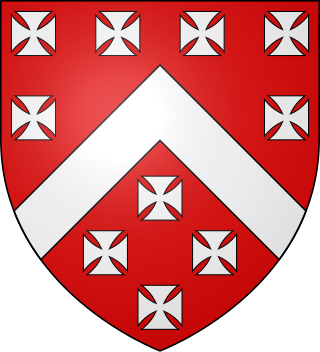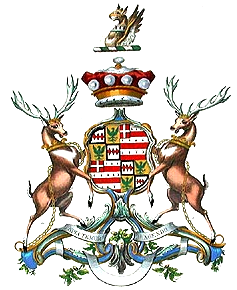
Baron de Ros of Helmsley is the premier baron in the Peerage of England, created in 1288/89 for William de Ros, with precedence to 24 December 1264. Premier baron is a designation and status awarded to the holder of the most ancient extant barony of the Peerage of England. Before the Dissolution of the Monasteries the Prior of the Order of St John in England was deemed the premier baron.

The title Baron Berkeley originated as a feudal title and was subsequently created twice in the Peerage of England by writ. It was first granted by writ to Thomas de Berkeley, 1st Baron Berkeley (1245–1321), 6th feudal Baron Berkeley, in 1295, but the title of that creation became extinct at the death of his great-great-grandson, the fifth Baron by writ, when no male heirs to the barony by writ remained, although the feudal barony continued. The next creation by writ was in 1421, for the last baron's nephew and heir James Berkeley. His son and successor William was created Viscount Berkeley in 1481, Earl of Nottingham in 1483, and Marquess of Berkeley in 1488. He had no surviving male issue, so the Marquessate and his other non-inherited titles became extinct on his death in 1491, whilst the barony passed de jure to his younger brother Maurice. However, William had disinherited Maurice because he considered him to have brought shame on the noble House of Berkeley by marrying beneath his status to Isabel, daughter of Philip Mead of Wraxhall, an Alderman and Mayor of Bristol. Instead, he bequeathed the castle, lands and lordships comprising the Barony of Berkeley to King Henry VII and his heirs male, failing which to descend to William's own rightful heirs. Thus on the death of King Edward VI in 1553, Henry VII's unmarried grandson, the Berkeley inheritance returned to the family. Therefore, Maurice and his descendants from 1492 to 1553 were de jure barons only, until the return of the title to the senior heir Henry, becoming de facto 7th Baron in 1553. Upon his death he was succeeded by his relative George Harding.

Earl of Ranfurly, of Dungannon in the County of Tyrone, a title in the Peerage of Ireland, was created in 1831 for Thomas Knox, 2nd Viscount Northland. He had earlier represented County Tyrone in the House of Commons, and had already been created Baron Ranfurly, of Ramphorlie in the County of Renfrew, in the Peerage of the United Kingdom in 1826. Knox was the eldest son of Thomas Knox, who represented Dungannon in the Irish House of Commons. He was created Baron Welles, of Dungannon in the County of Tyrone, in 1781, and Viscount Northland, of Dungannon in the County of Tyrone, in 1791. Both titles were in the Peerage of Ireland. Lord Northland also sat in the British House of Lords as one of the 28 original Irish Representative Peers.
Baron Lisle was a title which was created five times in the Peerage of England during the Middle Ages and Tudor period, and once in the Peerage of Ireland in the 18th century.

There have been three baronies created for the Gerard family who lived historically at Bryn, Ashton-in-Makerfield, Lancashire and Kingsley, Cheshire, in the 13th century. The third and current barony was created in 1876.

Earl of Dartrey, of Dartrey in the County of Monaghan, was a title in the Peerage of the United Kingdom. It was created in July 1866 for The 3rd Baron Cremorne.
The title Baron Ferrers of Chartley was created on 6 February 1299 for John de Ferrers, son of Robert de Ferrers, 6th Earl of Derby. The daughter of the 6th Baron Ferrers of Chartley, Anne, married Walter Devereux who was summoned to parliament as Lord Ferrers in her right. Their descendants became Earls of Essex and the peerage was forfeited in 1601 on the attainder of Robert Devereux, 2nd Earl of Essex, but restored to his son Robert in 1604, on whose death in 1646 the peerage fell into abeyance. The abeyance was terminated in 1677 when Robert Shirley, a grandson of one of the sisters of the 3rd Earl of Essex, was summoned as Lord Ferrers of Chartley with precedence to the original creation. In 1711, Shirley was created the 1st Earl Ferrers, but the Earldom and Barony separated at his death, the barony going to Elizabeth Shirley, the daughter of his eldest son, while the earldom went to his second son. On the 1741 death of Elizabeth Shirley, 15th Baroness Ferrers of Chartley and wife of the Earl of Northampton, the peerage again briefly fell into an abeyance that was resolved in 1749 by the death of two of the three heiresses, leaving the surviving daughter, Charlotte Compton, wife of the Marquess Townshend, as 16th Baroness Ferrers of Chartley. The barony continued, merged with the marquessate, until the death of George Ferrars Townshend, 3rd Marquess Townshend in 1855, when it again fell into abeyance between his two sisters and their heirs. It remains in abeyance.

Edward Hussey-Montagu, 1st Earl Beaulieu, KB (1721–1802), was a British politician. He was married to Isabella Montagu, Dowager Duchess of Manchester, a rich heiress.

Lieutenant-General Charles Butler, 1st Earl of Arran, de jure3rd Duke of Ormonde (1671–1758) was an Anglo-Irish peer. His uncle Richard was the 1st Earl of Arran of the first creation. The titles were re-created for Charles in 1693. His elder brother, the 2nd Duke of Ormonde, was attainted during the Jacobite rising of 1715, but in 1721 Arran was allowed to buy the estate back. At the death of the 2nd Duke, he succeeded as de jure 3rd Duke of Ormonde in the Irish peerage but did not claim the title.

Dartrey Forest is a forest and estate near Rockcorry in north-west County Monaghan, Ireland. It was formerly part of the Barony of Dartrey and was the country estate of the Dawson family, who had the title Earl of Dartrey from 1866 to 1933.

Thomas Dacre, 6th Baron Dacre of Gilsland was a medieval English nobleman.
Richard Dawson, 1st Earl of Dartrey KP, styled the Hon. Richard Dawson until 1827 and the Lord Cremorne from 1827 to 1866, was an Anglo-Irish Liberal, and later Liberal Unionist, politician.

John Montagu, Marquess of Monthermer, 1st Baron Montagu of Boughton was a British peer.

The Earldom of Harborough was a title in the Peerage of Great Britain created in 1719 for Bennet Sherard, who had previously been made Baron Harborough (1714) and Viscount Sherard, with the viscountcy ending with the death of its original holder in 1732, but the other titles, created with special remainders to the grantee's cousin, persisted until 1859.
Richard Dawson of Dawson Grove, County Monaghan was an Irish Member of Parliament.
John Vesey was a Church of Ireland clergyman.
Richard Dawson was an Irish Member of Parliament.
Richard Thomas Dawson, 2nd Baron Cremorne was an Irish peer.
Vesey Dawson, 2nd Earl of Dartrey, styled Viscount Cremorne between 1866 and 1897, was an Irish Liberal politician.
Thomas Vesey Dawson was an Irish Whig politician and army officer.












